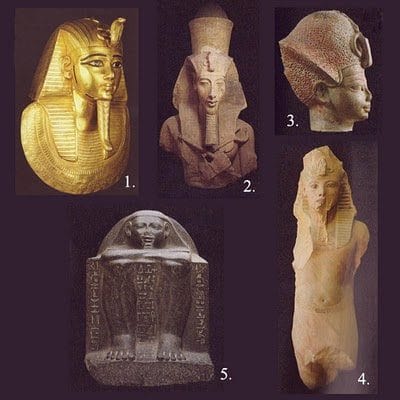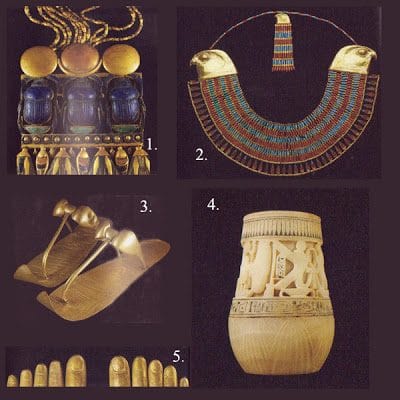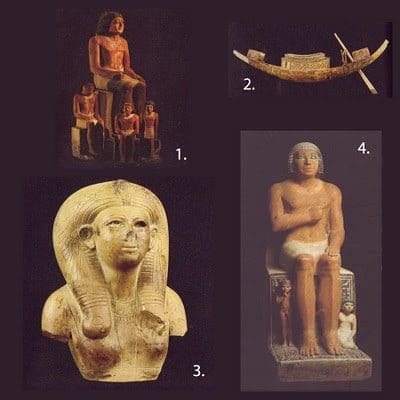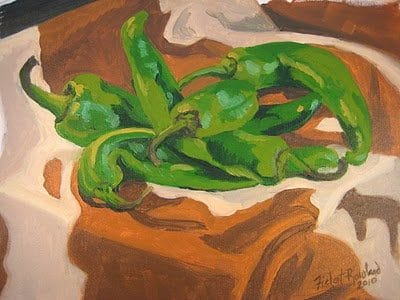Art Tour: King Tut at the Denver Art Museum-part 2 | Elysian Studios
In my previous post, I covered the basics of preparing to visit the King Tut exhibit at the DAM, but if you can’t get to the museum, I’d like to share some of my favorite pieces in the collection. All of the pictures in this post are from the book “Tutankhamun: The Golden King and the Great Pharoahs” by Zahi Hawass. This is the Official Souvenir Guide to the Exhibition. Dr. Hawass is an impressive archaeologist, and I’m amazed at how much he continues to discover and share about Ancient Egyptian culture. If you listen to him speak about his discoveries, or watch him on a National Geographic DVD, his joy and excitement shines through and is contagious!
There are three major focuses of the artifacts in the King Tut exhibit: The Pharoahs, The Treasures, and The Household.
The Pharaohs:
“The word ‘pharaoh’ comes from a Hebrew word in the Old Testament referring to the ruler of Egypt, derived from an ancient phrase, per aa, meaning ‘great house.’ ” says Hawass.

1. “Funerary Mask of Psusennnes” ,gold inlaid with lapis lazuli and black and white glass. Solid gold masks like this were used to cover the face, head and chest of the Pharaoh mummies. The cobra and false beard point to the royal and godly status of Pharaoh, and gold was believed to be connected with the light of the sun, one of the major gods in Egyptian religion.
2. “Sculpture of Amenhotep IV” , sandstone. Akhenaten, also known as Amenhotep IV, was King Tutankhamun’s father, who controversially changed Egypt’s worship from the sun god “Amun” to the sun god “Aten.” In fact, King Tut’s name at birth was Tutankhaten, and changed to Tutankhamun after he inherited the throne and restored worship to Amun. This lage and impressive sculpture of Amenhotep IV once “stood against large square pillars in the colonnade of the King’s temple to the god Aten at East Karnak,” says Hawass.
3. “Amenhotep III” , plastered and painted unbaked clay. There are different significances to the crowns portrayed by the Pharaohs. This portrays the “blue crown”, or “war crown.” The statue of Amenhotep IV (#2) portrays the “double crown” which symbolizes Pharaoh’s rule over both Upper and Lower Egypt, and the Funerary Mask (#1) displays the “Nemes Headdress” which is the most common crown we associate with Pharaoh, and symbolizes his divinity.
4. “Colossal Statue of King Tutankhamun”, quartzite. This is a gorgeous statue, and it’s worth the trip to the DAM just to see it. It is one of a pair of statues found in the funerary temple of Ay and Horemheb, two very influential Egyptian leaders at the time of Tut’s reign. The smooth belly, contrasted with the striated skirt and intricately painted details of his face are something to behold. This is why we are still fascinated with Ancient Egypt!
5. “Statue of Hetep”, stone. Another example of fascinating and influential Egyptian Art is this abstract block sculpture of Hetep, who probably served in the court of Amenhotep I. It depicts a seated figure and focuses on the carved hieroglyphic inscriptions, rather than characteristic details of the figure itself.
The Treasures:
Hawass states that “Ancient Egypt is legendary for its wealth in gold. It formed the basis for beautiful jewelry and was used to cover boxes, coffins, and statuettes. The bodies of gods were made of gold, and gold could protect the deceased in the afterlife.” 
1. “Necklace with Three Scarabs”, gold and lapis lazuli. This necklace was found within the wrappings of King Tut’s mummy. “This piece contains many magical elements, including the three gold disks. The outer two signify the sun and the middle one, cradled in a crescent, signifies the moon, ” informs Hawass.
2. “Collar of Neferuptah”, gold, carnelian and feldspar. This was found on the mummy of Amenemhat II’s daughter. Many of the large bib-style necklaces on display include a decorative counter-weight at the back to ensure the piece hung properly. It is assumed Neferuptah wore this during her life as well as the afterlife, and Hawass says this style of jewelry was widely popular with both royals and nonroyals.
3.”Tutankhamen’s Golden Sandals” ,gold. These sandals adorned the feet of Tut’s mummy and are significant not only becaue they are truly beautiful and wonderfully crafted, but also because their size is a reminder as to how small this 19 year old ruler was when he died. “The Egyptians believed that Pharaohs were turned to gold in the afterlife, so they needed matching footwear,” says the DAM.
4. “Ungent Vessel” ,alabaster. Found in Tutankhamun’s tomb, this vessel was made in three layers. A thick shell of carved alabaster is on the exterior, a layer of openwork alabaster is in the middle, and a seperate thin lining of alabaster is nestled perfectly inside. The craftsmanship is remarkable! Winged cobras, cartouches, ankh-signs, and winged scarabs provide magical imagery to the piece that inspires the imagination.
5. “Golden Toe Covers” , gold. Tiny hollow gold finger and toe covers were formed and delicately carved to protect the Pharaoh’s extremeties as he traveled into the afterlife. The reason King Tut is so significant is because his tomb was the only tomb of an Egyptian Pharoah found intact. Many artifacts that were buried with Egyptian royalty were looted throughout the ages, leaving a historical void in our understanding of this culture.
The Household:
As with other royalty in history, the Egyptian Pharaohs had palaces full of wives, children, priests, viziers and viceroys, architects and artists. Unlike other ancient cultures, women enjoyed many rights in Egyptian society, including the rights to own property, run a business and defend herself in court.

1. “Four Figurines of Inty-shedu” , likely painted and plasterd clay. Inty-shedu was a workman who helped build the pyramids of Giza. This is a significant discovery made by Hawass himself of a nonroyal man, portrayed with a mustache (unlike the royalty), at different phases of his life. Hawass very animatedly recounts the day of his discovery on the museum audio tour.
2.”Model Boat” ,painted wood. This piece is one of 18 model boats found in Tut’s tomb. This is an example of something we saw in footage of the excavation, and then got to see in person at the DAM. Boats were believed to transport the dead to Abydos, the mythical burial place of the god Osiris.
3.”18th Dynasty Fragment of a Woman” , stone. “The dress, the collar, the beads, and the wig suggest the woman represented belonged to a royal family,” says Hawass. The rearing cobra at the top of her wig is also a symbol of royalty.
4. “The Priest Kai” , limestone with inlaid crystal. “Another one of my discoveries that is included in this exhibition is the statue of the priest Kai and his children. I found this statue concealed behind the false door inside Kai’s tomb at Giza,” recounts Hawass. “I will never forget how I felt when I peered through the hole in the false door, and saw the eyes of Kai gazing back at me. The moment when I first held this exquisite statue in my hands will remain in my memory forever.”
Zahi Hawass is a modern Indiana Jones! “For me, archaeology is not a just a job,” he states on his website. “It combines everything that I could want – imagination, intellect, action, and adventure!” You can follow his discoveries by subscribing to his RSS and Photoblog feeds from his website. For a great Egyptian adventure, much closer to home, view the King Tut Exhibit at the Denver Art Museum now through January 9, 2011. Feel free to comment with any questions you have about our research or our visit!


